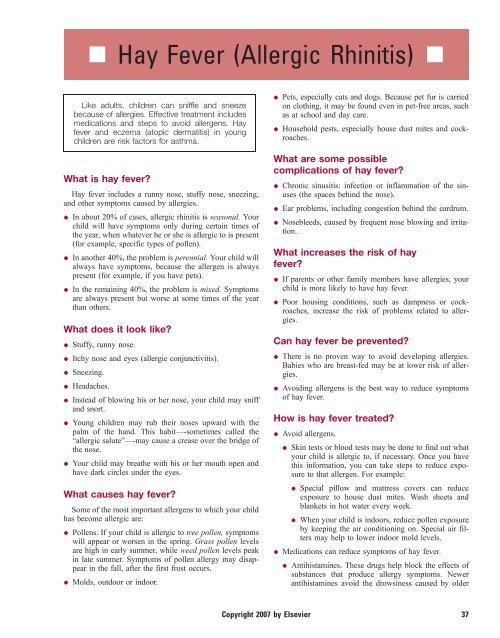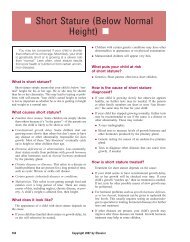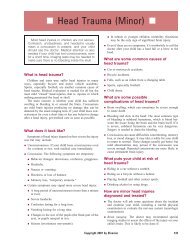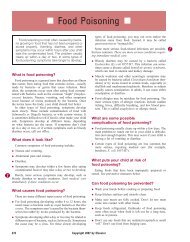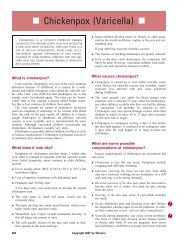Hay Fever (Allergic Rhinitis)
Hay Fever (Allergic Rhinitis)
Hay Fever (Allergic Rhinitis)
You also want an ePaper? Increase the reach of your titles
YUMPU automatically turns print PDFs into web optimized ePapers that Google loves.
n <strong>Hay</strong> <strong>Fever</strong> (<strong>Allergic</strong> <strong>Rhinitis</strong>) n<br />
Like adults, children can sniffle and sneeze<br />
because of allergies. Effective treatment includes<br />
medications and steps to avoid allergens. <strong>Hay</strong><br />
fever and eczema (atopic dermatitis) in young<br />
children are risk factors for asthma.<br />
What is hay fever<br />
<strong>Hay</strong> fever includes a runny nose, stuffy nose, sneezing,<br />
and other symptoms caused by allergies.<br />
In about 20% of cases, allergic rhinitis is seasonal. Your<br />
child will have symptoms only during certain times of<br />
the year, when whatever he or she is allergic to is present<br />
(for example, specific types of pollen).<br />
In another 40%, the problem is perennial. Your child will<br />
always have symptoms, because the allergen is always<br />
present (for example, if you have pets).<br />
In the remaining 40%, the problem is mixed. Symptoms<br />
are always present but worse at some times of the year<br />
than others.<br />
What does it look like<br />
Stuffy, runny nose.<br />
Itchy nose and eyes (allergic conjunctivitis).<br />
Sneezing.<br />
Headaches.<br />
Instead of blowing his or her nose, your child may sniff<br />
and snort.<br />
Young children may rub their noses upward with the<br />
palm of the hand. This habit—-sometimes called the<br />
“allergic salute”—-may cause a crease over the bridge of<br />
the nose.<br />
Your child may breathe with his or her mouth open and<br />
have dark circles under the eyes.<br />
What causes hay fever<br />
Some of the most important allergens to which your child<br />
has become allergic are:<br />
Pollens. If your child is allergic to tree pollen, symptoms<br />
will appear or worsen in the spring. Grass pollen levels<br />
are high in early summer, while weed pollen levels peak<br />
in late summer. Symptoms of pollen allergy may disappear<br />
in the fall, after the first frost occurs.<br />
Molds, outdoor or indoor.<br />
Pets, especially cats and dogs. Because pet fur is carried<br />
on clothing, it may be found even in pet-free areas, such<br />
as at school and day care.<br />
Household pests, especially house dust mites and cockroaches.<br />
What are some possible<br />
complications of hay fever<br />
Chronic sinusitis: infection or inflammation of the sinuses<br />
(the spaces behind the nose).<br />
Ear problems, including congestion behind the eardrum.<br />
Nosebleeds, caused by frequent nose blowing and irritation.<br />
What increases the risk of hay<br />
fever<br />
If parents or other family members have allergies, your<br />
child is more likely to have hay fever.<br />
Poor housing conditions, such as dampness or cockroaches,<br />
increase the risk of problems related to allergies.<br />
Can hay fever be prevented<br />
There is no proven way to avoid developing allergies.<br />
Babies who are breast-fed may be at lower risk of allergies.<br />
Avoiding allergens is the best way to reduce symptoms<br />
of hay fever.<br />
How is hay fever treated<br />
Avoid allergens.<br />
Skin tests or blood tests may be done to find out what<br />
your child is allergic to, if necessary. Once you have<br />
this information, you can take steps to reduce exposure<br />
to that allergen. For example:<br />
Special pillow and mattress covers can reduce<br />
exposure to house dust mites. Wash sheets and<br />
blankets in hot water every week.<br />
When your child is indoors, reduce pollen exposure<br />
by keeping the air conditioning on. Special air filters<br />
may help to lower indoor mold levels.<br />
Medications can reduce symptoms of hay fever.<br />
Antihistamines. These drugs help block the effects of<br />
substances that produce allergy symptoms. Newer<br />
antihistamines avoid the drowsiness caused by older<br />
Copyright 2007 by Elsevier 37
38 n <strong>Hay</strong> <strong>Fever</strong> (<strong>Allergic</strong> <strong>Rhinitis</strong>)<br />
antihistamines. Most, like Claritin (generic name: loratadine)<br />
or Allegra (generic name: fexofenadine), are<br />
taken orally. A nasal antihistamine is also available.<br />
Decongestants. Decongestants such as Sudafed (generic<br />
name: pseudoephedrine) can help to reduce stuffy<br />
nose. Decongestants are available without a prescription<br />
and come in oral and nasal spray forms. Don’t<br />
give your child nasal sprays for more than a few days.<br />
Nasal steroids. If your child’s symptoms are severe or<br />
do not improve, stronger medications called steroids<br />
may be used. These medications, such as fluticasone<br />
and budesonide, can safely reduce allergic inflammation<br />
in the nose.<br />
Other medications. Singulair (generic name: montelukast)<br />
can also reduce hay fever. This drug is also used<br />
to treat asthma.<br />
Some medications are most effective if started a week<br />
or two before the start of pollen season. If your child<br />
has hay fever, try to use the lowest dose that controls<br />
symptoms.<br />
If your child’s symptoms do not get better with treatment,<br />
we may recommend a visit to a specialist in allergic<br />
diseases (an allergist/immunologist). This specialist<br />
may recommend further treatments, such as immunotherapy<br />
(allergy shots) to reduce your child’s allergies.<br />
When should I call your office<br />
Call our office if:<br />
Your child’s allergic symptoms don’t get better with<br />
treatment, or if they get worse.<br />
Your child develops signs of asthma, such as wheezing<br />
(high-pitched sounds coming from the lungs) or coughing.<br />
Your child develops signs of sinusitis (such as fever,<br />
headache) or if he or she simply isn’t feeling well.<br />
Copyright 2007 by Elsevier


